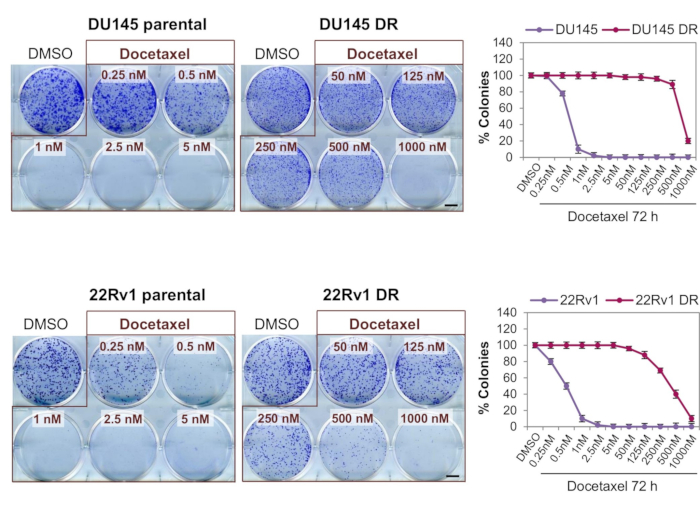Crystal Violet Staining: A Technique to Visualize Drug-Resistant Cancer Cells Using Colony Formation Assays
Abstract
Source: Mohr, L. et al., Generation of Prostate Cancer Cell Models of Resistance to the Anti-mitotic Agent Docetaxel. J. Vis. Exp. (2017)
In this video, we demonstrate a cell viability assay using a crystal violet staining procedure for chemotherapeutic drug-resistant cancer cells.
Protocol
1. Functional Characterization of Acquired Docetaxel Resistance by Colony Formation Assay
NOTE: In this protocol, chemoresistance has been evaluated using colony formation assays. Alternative methods used to evaluate cell viability (i.e., MTS assays) can be used based on investigators' preferences.
- Plate 2,000 cells (DU145 or 22Rv1, both parental and Docetaxel-resistant) per well in 6-well plates, using 2 mL of media per well.
- After 24 h, add increasing concentrations of Docetaxel (parental cells: 0.25, 0.5, 1, 2.5 and 5 nM; DR cells: 50, 125, 250, 500 and 1,000 nM) for both DU145 and 22Rv1 cell lines. Add DMSO only to one well as a control at the same volume used for the highest Docetaxel dose.
- After 72 h, aspirate drug containing media and add fresh Docetaxel-free media.
- Incubate plates for 1-2 weeks until colonies are visible under the microscope.
- To stain the colonies, wash them gently with 2-3 mL PBS and incubate them with 2-3 mL crystal violet solution (0.1% w/v in 10% formalin) for 20 min inside the tissue culture hood or a fume hood.
- Remove staining solution and wash plates with 2-3 mL of H2O, remove H2O and air-dry plates.
- Analyze result by visualizing the wells and manually counting colonies with the help of a marker pen (to avoid counting the same colonies twice) and represent the percentage of cell viability in a graph. Take digital images of the plates for figure representation (Figure 1).
Representative Results

Figure 1: Functional and phenotypic characterization of the Docetaxel-resistant cell models. Representative colony formation assays of parental and Docetaxel-resistant cells treated with the indicated Docetaxel concentrations for 72 h. Percentage of colonies for every treatment concentration is represented in the included graph. The experiments are triplicates and data represents the mean ± SD. Scale bars = 5 mm.
Divulgaciones
The authors have nothing to disclose.
Materials
| DU145 cells | ATCC | HTB-81 | |
| 22Rv1 cells | ATCC | CRL-2505 | |
| Docetaxel | Selleck Chemicals | S1148 | in DMSO (10mM) |
| 6-well tissue culture plates | Falcon | 353046 | |
| RPMI 1640 Medium | Gibco | 11875093 | Supplemented with 10% FBS and 1% Penicilin/Streptomycin |
| Foundation B Fetal Bovine Serum | Gemini | 900208 | |
| 1X Phosphate-Buffered Saline (PBS) | Corning | 21-040-CM | |
| Crystal Violet | Sigma-Aldrich | C0775 | |
| 10% Formalin Solution | Sigma-Aldrich | HT501128 |

